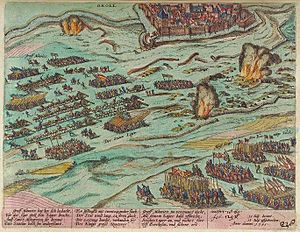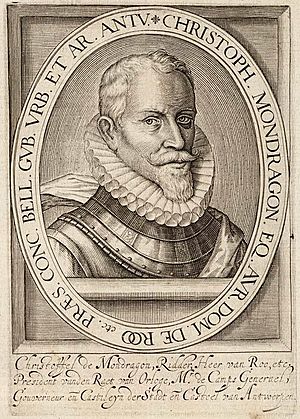Battle of the Lippe facts for kids
Quick facts for kids Battle of the Lippe |
|||||||
|---|---|---|---|---|---|---|---|
| Part of the Eighty Years' War | |||||||
 'Defeat of the Dutch States Army near Wesel, 1595'. By Simon Frisius and Frans Hogenberg. |
|||||||
|
|||||||
| Belligerents | |||||||
| Commanders and leaders | |||||||
| Cristóbal de Mondragón Juan de Córdoba |
Maurice of Nassau Philip of Nassau (DOW) |
||||||
| Strength | |||||||
| 500 cavalry | 500–700 cavalry | ||||||
| Casualties and losses | |||||||
| 60 | 100–300 | ||||||
The Battle of the Lippe was a fight between horse soldiers (cavalry) on September 2, 1595. It happened near the Lippe river in what is now Germany. Spanish cavalry, led by Juan de Córdoba, fought against Dutch and English cavalry, led by Philip of Nassau.
This battle was part of the Eighty Years' War, a long conflict where the Dutch fought for their freedom from Spain. The Dutch leader, Maurice of Nassau, was trying to capture the town of Groenlo. But an experienced Spanish general, Cristóbal de Mondragón, gathered an army to help Groenlo. Maurice had to stop his attack on the town.
Mondragón then moved his troops near Wesel to protect another town called Rheinberg. Maurice wanted to trick Mondragón into a big battle. He planned an ambush, but Mondragón found out about it. The Spanish general then set his own trap for the Dutch.
The Dutch tried to capture a Spanish supply group to make the Spanish army chase them. Maurice waited with his army by the Lippe river. However, Mondragón had already sent more soldiers to protect the supplies. He also hid many cavalry soldiers in a nearby forest. The Spanish forces surprised the Dutch, causing many losses, including Philip of Nassau himself.
Contents
Why the Battle Happened
War Between Nations
In 1595, Henry IV of France declared war on Spain. This was because Philip II of Spain kept helping the Catholic League in France. France then teamed up with Elizabeth I of England and the Dutch Republic. Both England and the Dutch Republic were already fighting Spain.
The Spanish Netherlands (which is now Belgium and Luxembourg) was caught in the middle of these wars. French and Dutch armies even tried to create a path to connect their countries. The new Spanish leader in the Netherlands, the Count of Fuentes, focused on fighting in France. This left fewer Spanish soldiers to defend against Dutch attacks.
The Siege of Groenlo
In July, while Fuentes was busy fighting in France, Maurice of Nassau, the leader of the Dutch Republic, gathered a large army. He had 6,000 foot soldiers, some cavalry, and 16 cannons. Maurice led his army to attack Groenlo, a town in the County of Zutphen.
Groenlo was a medium-sized town. It had strong defenses with five bulwarks (strong parts of a fort). About 600 soldiers defended the town, led by Jan van Stirum.
When he heard about the attack on Groenlo, Cristóbal de Mondragón acted quickly. He was an old but very experienced Spanish governor of Antwerp. Mondragón gathered soldiers from different garrisons (military bases). He marched his small army towards Groenlo.
Mondragón's army included:
- Two Spanish tercios (large units of soldiers).
- An Irish regiment.
- A Swiss regiment.
- 1,300 cavalry led by Juan de Córdoba.
- German soldiers led by Frederick van den Bergh.
Mondragón was over 80 years old but still rode a horse into battle. He was famous for his bravery and was even respected by some of his enemies. Mondragón wanted to help Groenlo and also draw Maurice into a big battle.
However, Maurice heard that Mondragón was coming. He burned his supplies and tools and retreated about 2 kilometers from Groenlo. This allowed Mondragón to easily resupply the town.
Before the Battle
Armies Face Off
After securing Groenlo, Mondragón marched south to Rheinberg to protect it from the Dutch. He set up his army camp near Wesel. Maurice followed him and camped at Bislich. The Lippe river separated the two armies.
The Spanish position was strong. The Rhine river protected their rear and left side. The Lippe river and some hills protected their right side. For several weeks, the armies watched each other. They often had small fights when their cavalry went out to find food.
As time passed, the Spanish soldiers had to go further and further to find supplies. Maurice saw this as a chance. He planned a fake ambush on a Spanish supply group. His goal was to trick Mondragón into a larger battle where he could defeat the Spanish army. But Mondragón also hoped to trick Maurice.
The Ambushes
On September 1, Maurice gave the command of the ambush to his cousin, Philip of Nassau. Maurice told him to cross the Lippe river at dawn the next day. Philip was to hide in a wood where the Spanish supply group was expected to pass. His job was to attack the guards of the convoy.
Maurice wanted Philip to capture the supplies and bring them to the Dutch camp. This would force Mondragón to send a larger force to get them back. Then, when Mondragón's main army appeared, Philip was to retreat. This would lead the Spanish army into Maurice's main ambush. Philip had about 500 to 700 Dutch and English horsemen for this task. His brothers, Ernst Casimir and Ludwig Gunther, were with him.
However, the Spanish knew about the Dutch plan. Mondragón learned about it from English soldiers who had left the Dutch army. Other stories say Spanish spies told him. Either way, Mondragón prepared his own trap. The supply group, usually guarded by 300 foot soldiers and 150 cavalry, was reinforced. Mondragón added 300 more musketeers and a large group of cavalry led by Juan de Córdoba.
The Fight Begins
On September 2, at dawn, the Dutch forces crossed the Lippe river using a temporary bridge. Maurice waited with 5,000 foot soldiers and the rest of his cavalry. They were ready for battle on the hills near Wesel.
Philip of Nassau divided his troops into four groups. He sent 40 chosen men ahead to surprise the Spanish horses getting supplies. But these Dutch officers found a much larger Spanish force than they expected. They thought something was wrong and sent a message back to Philip.
Philip of Nassau, however, believed it was just the usual guards. He moved forward with his troops to attack the Spanish cavalry. He wanted to stop them from escaping.
The Dutch officers were right. Early that morning, two Spanish scouts had found signs of the Dutch crossing the river. Mondragón had already placed his cavalry beyond a forest. The area south of the Lippe had small woods mixed with open fields.
Besides the soldiers guarding the supplies, Juan de Córdoba had at least seven cavalry groups. Mondragón had told the supply guards about the Dutch plan. He encouraged them to hold their ground, promising that the whole Spanish army was behind them.
A Surprise Attack
Philip of Nassau, leading 75 lancers, rode through a narrow path in a small forest. When he came out into an open field, he was surprised by the Spanish troops. These were led by Hendrik van den Bergh, followed by other Spanish cavalry.
Van den Bergh's soldiers, who carried harquebus (an early type of gun), saw the Dutch coming out of the forest. They fired their guns and then charged, starting the fight. A fierce battle began.
The Dutch troops were in eight groups, but they were caught by surprise in a narrow space. They couldn't use their long lances. So, they had to fight with swords and pistols. Philip of Nassau, his brothers, and his cousin Ernst von Solms were badly wounded and fell from their horses early in the fight.
Other Dutch troops tried to help their wounded commanders but couldn't. Some Dutch soldiers started to run away. However, an English captain, Nicholas Parker, managed to gather the fleeing soldiers. He renewed the attack, causing confusion among the Spanish cavalry. The fight then moved out of the wood into open ground.
At first, the Dutch seemed to be winning. They managed to break apart two or three Spanish cavalry groups. But then, Paulo Emilio Martinengo charged his company into the Dutch flank (side). This routed a Dutch group. This allowed Córdoba to regroup his Spanish troops and attack again, this time successfully.
Despite strong resistance from the Dutch, they were finally broken. They fled in a disorganized way, trying to reach the Lippe river to escape. Córdoba sent his cavalry to chase them. Many Dutch soldiers couldn't find a good place to cross the river and drowned. The Spanish freed their captured soldiers and got back the supplies the Dutch had taken.
After the Battle
Heavy Losses
The battle was known for the many Dutch commanders who died. Philip of Nassau was shot at close range with a harquebus at the start of the fight. He was badly wounded and his clothes caught fire. Robert Vere, brother of an English colonel, was killed by a lance to the face. Other Dutch commanders were also killed.
Count Ernst of Solms was seriously wounded and captured. He and Philip were taken to Rheinberg. Mondragón and their Catholic cousins visited them. Spanish surgeons treated them, but both Dutch commanders died from their wounds. Philip died the night after the battle, and Solms died three days later. Count Ernst Casimir was captured but later set free after a payment of 10,000 florins. Mondragón sent him back to Maurice of Nassau with the bodies of the dead counts. They were buried with honors.
The number of losses varies depending on the source. One source says the Dutch lost 88 horses, had 83 prisoners, and 24 killed. Another source claims more than 300 Dutch soldiers were killed, compared to about 60 Spanish losses. Spanish sources claim their losses were 19 men killed. They also said the Dutch lost three flags and about 400 horses. On the Spanish side, only a few commanders were wounded, but not fatally.
A Small but Important Fight
An English writer, Edward Grimeston, described the Battle of the Lippe as "a small battle of young and hot bloods, who proved but bad merchants that got nothing." Even though it was a small battle, the Spanish army celebrated it with great joy. They fired cannons and muskets into the air.
The Spanish and Dutch armies stayed in their camps for 16 more days, watching each other. But no major battles happened. Maurice of Nassau tried to capture another town, but his plan was discovered. He also tried to stop some Spanish companies, but they managed to escape.
On October 11, Mondragón's army ran out of food for their horses. He decided to retreat. Maurice tried to cut off his escape, but Mondragón successfully led his troops to safety. Mondragón died on January 4, 1596, in the citadel of Antwerp. He was a very old general who had served Spain for many years.
See also
 In Spanish: Batalla de Lippe para niños
In Spanish: Batalla de Lippe para niños





